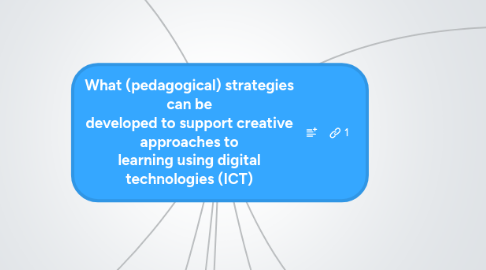
1. Note taking
2. Co-creation of rubrics and sharing these live
3. Need a destination before considering the tool
3.1. Technology helps us to be creative
3.2. Set out objectives - THEN decide the technology
3.2.1. http://i47.tinypic.com/2hmq1xw.jpg
4. Design processes
4.1. Deconstruct
4.2. Design
5. DEVELOPING THINKING SKILLS
5.1. Three Thinking Hats
5.1.1. White
5.1.2. Green
5.1.3. Red
5.2. Brainstorming
6. Assessment
7. Problem Solving
7.1. Real/engaging problems
7.2. Creative thinking?
7.2.1. First things first!
7.2.1.1. We need a VISION for learning
7.2.2. Creativity
7.3. COMPUTATIONAL THINKING
7.3.1. Can be carried out across subjects
7.3.2. Google Definition
7.3.2.1. Deconstruction
7.3.2.2. Pattern Generalisation & Abstraction
7.3.2.3. Pattern Generation
7.3.2.4. Algorithm Design
7.3.3. Digital Literacy
7.3.3.1. creating for the web
7.3.4. Purpose of computing is about solving real world problems. Not just about code.
7.3.5. Problem Solving
7.3.5.1. Process
7.4. VISUAL THINKING & LEARNING
7.4.1. Visual Metaphors
7.4.1.1. User Interfaces
7.4.1.1.1. Computers
7.4.1.1.2. Mobile
7.4.1.1.3. Domestic e.g Car /Home
7.4.2. Media
7.4.2.1. Video
7.4.2.1.1. assesment
7.4.2.1.2. documentation
7.4.2.1.3. narrative
7.4.2.2. Images
7.4.2.3. Remix
7.4.3. Visual Instruction
7.4.3.1. Infographics
7.4.3.2. Programming/Coding
7.4.3.2.1. Scratch
7.4.3.2.2. Alice
7.4.3.2.3. Blockly
7.4.4. Mapping
7.4.4.1. MindMaps
7.4.4.2. Online Maps
7.4.4.2.1. Finding mathematical shapes using Google earth/maps (Douglas Butler) Tom Barrett
7.4.4.2.2. Graphing from google earth - like maths maps but even more attitude!
7.4.5. Curation
7.4.5.1. Pinterest
7.4.5.2. Flickr
7.4.5.3. Scoop.it
7.4.5.4. E-Portfolios
7.4.6. screen capture
7.4.6.1. Jing
7.4.6.2. Skitch
7.4.7. Narrative
7.4.7.1. Storyboarding
7.4.7.1.1. Collaborative
8. For too long we've focussed on the technology rather than the teachers and their pedagogy.
9. E-Portfolios
9.1. Enriching feedback from multiple sources
10. EU-LLP
11. HANDS-ON
12. TEACHING
12.1. Work creatively with students, manage change (technology and pedagogy and expectations)
12.2. Digital Eclectism
12.2.1. bottom up movements enabled by mobile technology
12.2.1.1. Teachmeets
12.2.1.2. The Flat Classroom Project
12.3. programming isnt going to change the world but what we do with it may be very beneficial for children - its about creativity and learning
12.4. Creative classrooms
12.4.1. Put your device on the desk
12.4.2. No touch screens for dynamic software
12.4.3. \nBYOD appealing but not the answer to everything
12.4.4. Teaching computing science can be valuable across the curriculum
12.5. SEN and inclusivity
12.5.1. cognitive skills before fractions
12.6. Technology is assistive or enables
12.6.1. Roger Turner tells us sound system improved life for pupils and teachers.
12.6.2. John Galloway-ICT as tool 4 inclusion.all tech is assistive.children have needs not labels.ICT a supportive subject.focus on Lang.
12.7. Concerns
12.7.1. The media is hostile
12.7.2. Resistance to pedagogical change
12.7.2.1. Stop journalists publishing sound bites
12.7.2.1.1. Should journalists use sound bytes?
12.7.2.2. Senior management when it comes to mobile technologies
12.7.2.2.1. Think it through before you invest in technology
